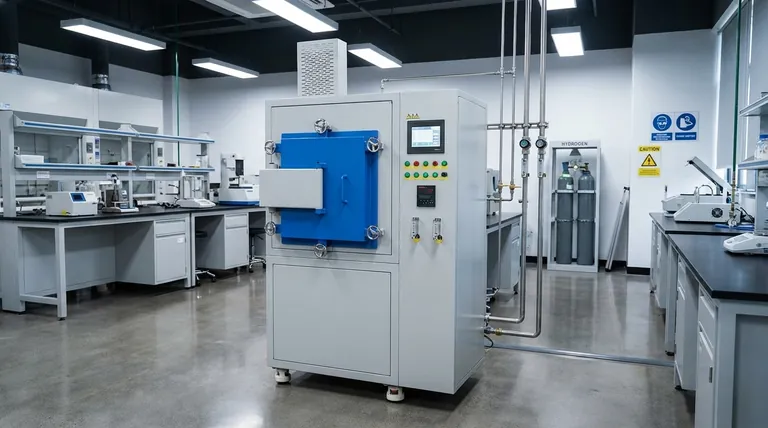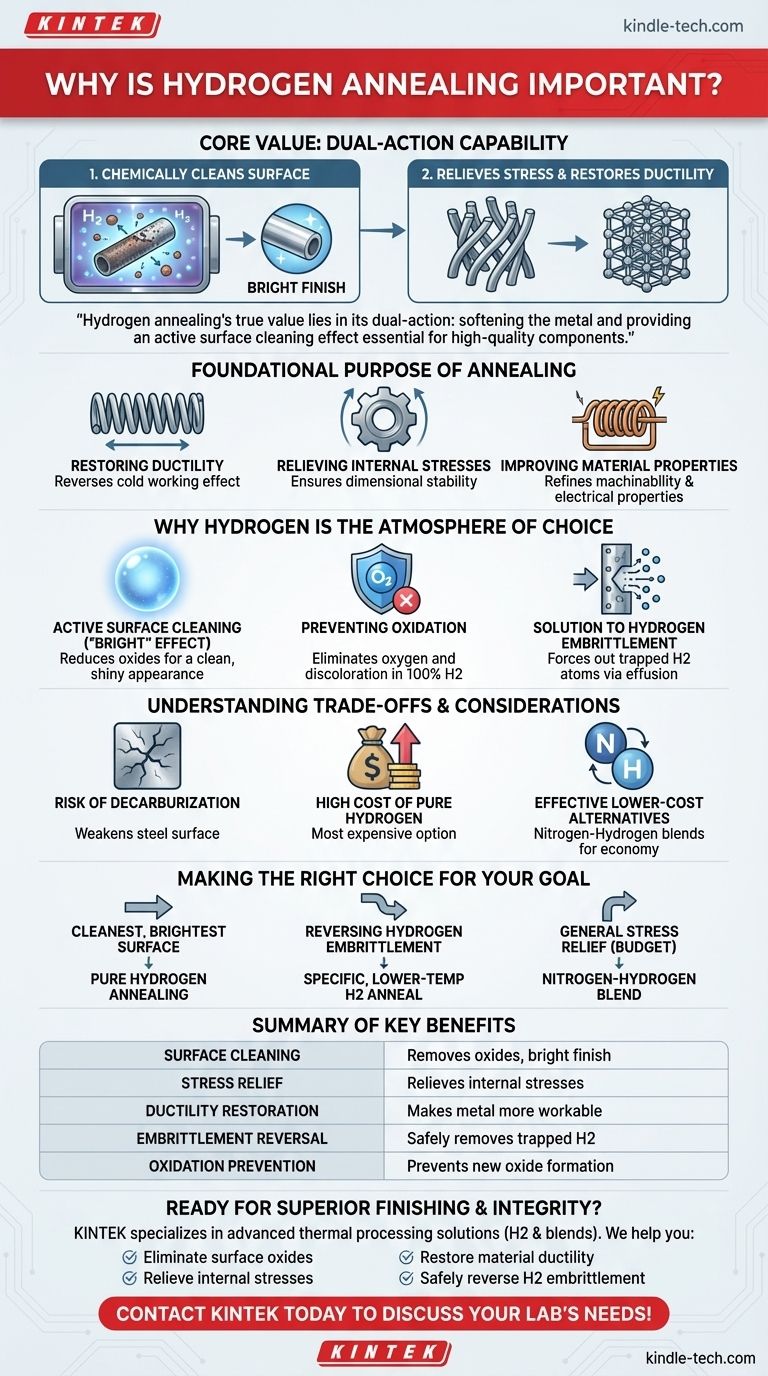At its core, hydrogen annealing is important because it is a highly effective heat treatment that leverages a pure hydrogen atmosphere to achieve two critical goals: it chemically cleans the metal's surface by removing oxides and prevents any new oxidation from forming. This results in a "bright," clean finish while simultaneously relieving internal stresses and restoring the material's ductility for further processing.
The true value of hydrogen annealing lies in its dual-action capability. It not only softens the metal and makes it more workable—the goal of all annealing—but it also provides an active surface cleaning effect that is essential for high-quality components, especially after processes like welding, coating, or cold working.

The Foundational Purpose of Annealing
Before focusing on the hydrogen element, it's crucial to understand what any annealing process is designed to accomplish. It is a foundational step in metallurgy used to refine a material's properties.
Restoring Ductility
When metal is bent, stretched, or compressed—a process known as cold working—it becomes harder but also more brittle. Annealing reverses this effect, restoring the material's ductility (its ability to be deformed without breaking), which allows for additional processing without the risk of cracking.
Relieving Internal Stresses
Processes like grinding, machining, or welding induce significant mechanical stresses within a material. If left untreated, these stresses can cause the part to distort or warp during subsequent high-temperature treatments or in its final application. Annealing releases these internal stresses, ensuring dimensional stability.
Improving Material Properties
Beyond stress and ductility, annealing can be used to refine other characteristics. It can improve the machinability of a material, making it easier to cut, and in some applications, it is used specifically to enhance a material's electrical properties.
Why Hydrogen Is the Atmosphere of Choice
Using a controlled atmosphere is what elevates standard annealing. Hydrogen is chosen for its unique and powerful chemical properties, which go far beyond simply protecting the material from air.
Active Surface Cleaning (The "Bright" Effect)
Hydrogen is a highly reducing gas. This means it actively reacts with and removes oxides that are already present on the metal's surface. This "surface cleaning" is what produces a clean, scale-free, and shiny appearance, earning the process the name bright annealing.
Preventing Oxidation and Discoloration
Heating metal in the presence of oxygen causes oxidation, leading to discoloration and surface scaling. By performing the heat treatment in a 100% hydrogen atmosphere, oxygen is eliminated, and the formation of new oxides is completely prevented.
A Surprising Solution to Hydrogen Embrittlement
Paradoxically, while trapped hydrogen atoms are the cause of hydrogen embrittlement—a condition where metal becomes brittle—a hydrogen anneal is also the solution. By heating the material to a relatively low temperature (200-300 °C) for several hours, trapped hydrogen is forced out through effusion. This is a critical step immediately after welding or galvanizing, processes known to introduce hydrogen into the material.
Understanding the Trade-offs and Considerations
While powerful, hydrogen annealing is a specialized process with specific challenges that must be managed for successful application.
The Risk of Decarburization in Steel
Hydrogen can react with the carbon in steel parts, a process known as decarburization. This can weaken the surface of the steel, so careful process control and precautions are necessary to avoid damaging the material's integrity.
The High Cost of Pure Hydrogen
An atmosphere of 100% hydrogen is the most expensive option for controlled atmosphere annealing. This cost must be justified by the need for the superior surface finish and cleaning properties that it provides.
Effective Lower-Cost Alternatives
For applications where the absolute brightest finish is not required, nitrogen-hydrogen blends offer an effective and more economical alternative. These blends still provide excellent protection against oxidation and can deliver many of the benefits of pure hydrogen at a lower operational cost.
Making the Right Choice for Your Goal
Selecting the correct annealing process depends entirely on the material's condition and the desired outcome for the final part.
- If your primary focus is achieving the cleanest, brightest possible surface: Pure hydrogen annealing is the superior choice due to its active oxide-reducing properties.
- If your primary focus is reversing hydrogen embrittlement after welding or plating: A specific, lower-temperature hydrogen anneal is the prescribed method for removing trapped hydrogen atoms.
- If your primary focus is general stress relief with a budget constraint: A nitrogen-hydrogen blend often provides sufficient oxidation prevention and is a more cost-effective solution.
Ultimately, choosing the right atmospheric treatment is a critical decision for ensuring both the aesthetic quality and the structural integrity of your final component.
Summary Table:
| Key Benefit | How Hydrogen Annealing Helps |
|---|---|
| Surface Cleaning | Removes existing oxides, creating a bright, scale-free finish. |
| Stress Relief | Relieves internal stresses from welding or cold working. |
| Ductility Restoration | Makes metal more workable for further processing. |
| Hydrogen Embrittlement Reversal | Safely removes trapped hydrogen atoms after welding or plating. |
| Oxidation Prevention | Pure hydrogen atmosphere prevents new oxide formation during heating. |
Ready to achieve superior metal finishing and component integrity?
At KINTEK, we specialize in advanced thermal processing solutions, including hydrogen annealing furnaces and controlled atmosphere systems. Whether you need the bright, oxide-free finish of pure hydrogen annealing or the cost-effective performance of nitrogen-hydrogen blends, our lab equipment is designed to meet the precise demands of your laboratory or production facility.
We help you:
- Eliminate surface oxides and prevent discoloration.
- Relieve internal stresses for dimensional stability.
- Restore material ductility for further processing.
- Safely reverse hydrogen embrittlement in critical components.
Let our experts help you select the right annealing process for your goals. Contact KINTEK today to discuss your lab's needs!
Visual Guide

Related Products
- Controlled Nitrogen Inert Hydrogen Atmosphere Furnace
- 1200℃ Controlled Atmosphere Furnace Nitrogen Inert Atmosphere Furnace
- 1400℃ Controlled Atmosphere Furnace with Nitrogen and Inert Atmosphere
- 1700℃ Controlled Atmosphere Furnace Nitrogen Inert Atmosphere Furnace
- Vacuum Heat Treat Furnace and Levitation Induction Melting Furnace
People Also Ask
- What is a hydrogen furnace? Unlock Oxide-Free Processing for Superior Materials
- What are the effects of hydrogen (H2) in a controlled furnace environment? Mastering Reduction and Risk
- What is the temperature of a hydrogen furnace? Unlocking High-Temp, Oxide-Free Processing
- What is hydrogen atmosphere heat treatment? Achieve Superior Surface Purity & Brightness
- When would you need to use a controlled atmosphere? Prevent Contamination and Control Reactions



















